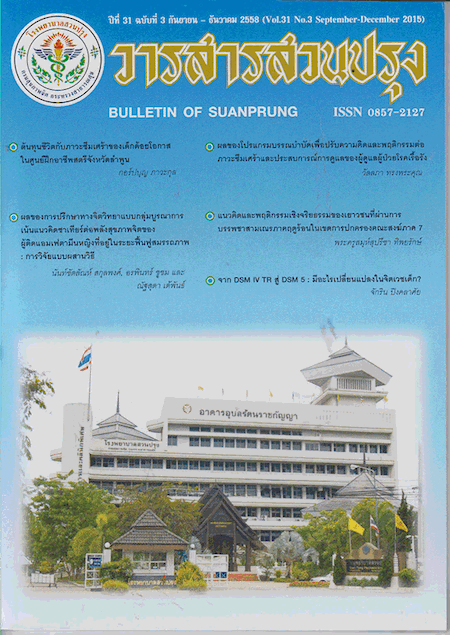The Study of Life Assets and Depression of Underprivileged Children
Main Article Content
Abstract
Objective: To study the life assets between depressed and non depressed underprivileged children at the Women Vocational Training Center in Lamphun
Methods: A descriptive research was conducted to collect data from the targeted 354 students who are underprivileged at the Women Vocational Training Center in Lamphun. A demographic questionnaire, the Life Assets Questionnaire (Youth version) for Thai youth aged 12-25 years old and the Thai version of Center for Epidemiologic Studies-Depression Scale [CES-D] were used for evaluation. However, the life assets data was analyzed by using the Microsoft Excel program and compared that by using the t-test statistics.
Results: The study reveals that there are depressed participants 28.53% The overall life assets level of the depressed and non depressed participants is moderate (64% and 68.9%) particularly, the life assets in terms of the power of family is in the highest level whereas the power of community is the lowest. Compared with the participants who are not depressed it appears that the overall life assets of the depressed participants are significantly lower statistically.In addition, in consideration of each power, the power of self, peer and community of the depressed participants are significantly lower than that of the non depressed participants.
Conclusion: All in all, the study suggests that the life assets that should be improved the most among the underprivileged children is the power of community. For the depressed participants, the power of self and peer should be strengthened since their power of family is initially strong. Moreover, if their weak life assets are simultaneously supported and improved, it is likely that the underprivileged youth will gain mental immunity that wards off the risky factors that entail emotional and behavioral problems.
Keywords: Life assets, Depression, Underprivileged children
Article Details
บทความหลังผ่านการปรับแก้จากกองบรรณาธิการแล้ว เป็นลิขสิทธ์ของวารสารจิตเวชวิทยาสาร โรงพยาบาลสวนปรุง กรมสุขภาพจิต กระทรวงสาธารณสุข ห้ามเผยแพร่เพื่อประโยชน์ทางการค้าโดยไม่ได้รับอนุญาต แต่อนุญาตให้เผยแพร่บทความดังกล่าวเพื่อประโยชน์ทางการศึกษาแก่ประชาชนทั่วไป ทั้งนี้กองบรรณาธิการไม่จำเป็นต้องเห็นด้วยกับบทความหรือข้อคิดเห็นใดๆ ที่ปรากฏในวารสารสวนปรุง

